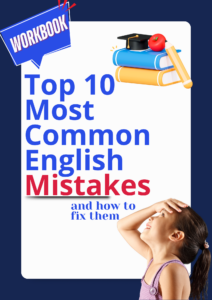Table of Contents
ToggleTop 10 Most Common English Mistakes
and how to fix them
Speaking English fluently isn’t just about knowing the words—it’s about using them the right way. Today, we’re going to tackle 10 of the most common speaking mistakes that are holding you back from becoming your most fluent, confident self.
In this lesson, I’m going to show you exactly what’s causing these errors and how you can fix them once and for all. Ready? Let’s get started!
Mistake 1: Using the wrong article: Confusing “a”, “an”, and “the”
Why does this happen? A, an, the…it can be confusing trying to figure out which article to use in a sentence. “A” and “an” are used for general things with a broad range of possibilities, while the is used for something specific or something that has already been mentioned.
For example, can you tell which one of these sentences is correct?
Incorrect: ‘I saw a movie last night. A movie was great.’
Correct: ‘I saw a movie last night. The movie (It) was great.’
Why? The first sentence introduces the idea of a movie, but isn’t specific about which movie, so we use ‘a movie.’ In the second sentence, we’re now talking about that specific movie you saw, so we need to use ‘the movie’ or ‘it’ to specify that we are specifically talking about the movie we watched last night.
The fix:
- Use ‘a’ or ‘an’ when you’re talking about something for the first time or something that’s not specific.
- Use ‘the’ when you’re referring to something specific or something you’ve already mentioned.”
Mistake 2: Confusing -ing and -ed adjectives
Why is this confusing? It’s because English uses ‘-ing’ and ‘-ed’ differently, and many languages don’t make this distinction between the two.
Here’s the rule:
- ‘-ing’ describes something or someone: ‘The movie is boring.’
- ‘-ed’ describes an emotion or how you feel: ‘I’m bored because of the movie.’
Practice: Which one of these sentences is correct?
The book is excited.
Correct- This movie is exciting.
The Fix:
Remember this rule:
- Use -ing to describe the thing causing the feeling.
- Use -ed to describe the person feeling it.
Mistake 3. Mixing Up Similar-Sounding Words
What’s the mistake?
Learners often confuse words like assistant and assistance, and advice and advise because they sound similar, but these words have different meanings.
Practice: Which one of these sentences is incorrect?
- Can you provide me with some assistant?
- I am your new assistance.
- I could use some advise.
- Could you advice me on which car to buy?
None of these sentences are correct!
The fix:
Learn the exact meanings of these words:
- Assistant- person who helps someone else, usually in a job or other task. “She is the boss’s assistant.”
- Assistance- the act of helping or supporting. “I need your assistance to move this table.”
- Advice- A suggestion or guidance (noun). “Can you give me some advice about studying English?”
- Advise- To recommend or suggest (verb). “I advise you to practice speaking every day.”
Focus on practicing these words in context and listen carefully to stress patterns in pronunciation.
Mistake 4: Mixing Up Adjectives and Adverbs
Why does this happen?
Adjectives describe nouns, while adverbs describe verbs, so confusing the two can lead to awkward sentences.
Practice: Which one of these sentences is correct?
- Incorrect: “She sings beautiful.”
- Correct: “She sings beautifully.”
Why?
“Beautiful” describes a noun, but “beautifully” is needed here to describe the verb/action (sings).
The Fix:
- Use adjectives for nouns (She is beautiful.).
- Use adverbs for actions (She sings beautifully.).
Mistake 5: Error in question structure: Leaving off auxiliary verbs
Why does this happen?
Many languages don’t use auxiliary verbs like “does” to form questions, leading to errors in English question structures.
Practice: Which one of these sentences is correct?
Incorrect: “How it looks like?”
Correct: “What does it look like?”
Why?
Most English questions require an auxiliary verb (“does”) to flip the statement into a question. This is true unless the main verb is be or it is continuous tense.
- Statement: “It looks like a beach.”
- Question: “What does it look like?”
- The Fix:
Think of “does” as a helper for forming questions. Practice common patterns like: - “Where does she work?”
- “What does he do?”
Mistake 6: Forgetting Prepositions
Why does this happen?
Learners often leave out prepositions because prepositions are used differently in different languages. But in English, prepositions are needed to get your point across.
Practice: Which one of these sentences is correct?
- Incorrect: “I’m good English.”
- Correct: “I’m good at English.”
- Incorrect: “I’m interested this topic.”
- Correct: “I’m interested in this topic.”
Why?
Prepositions link words to show relationships, such as time, place, or description. Each phrase in English often pairs with a specific preposition, and skipping them makes sentences incomplete.
The Fix:
Learn preposition-verb pairings like “good at,” “excited about,” and “interested in.” Practice with common examples!
Mistake 7: Mixing Up Countable and Uncountable Nouns
Why does this happen?
Uncountable nouns like “information” and “furniture” don’t take plural forms. Even though some languages treat them as countable, they are not countable in English.
Practice: Which one of these sentences is correct?
- Incorrect: “I need some informations.”
- Correct: “I need some information.”
Why?
Uncountable nouns represent concepts or things that can’t be divided into individual items without adding or changing words, so adding “-s” is unnecessary.
The Fix:
Use quantifiers like “some,” “a lot of,” or “a piece of” for uncountable nouns, and remembering NEVER to add an -s to uncountable nouns.
- “I need a lot of advice.”
- “She bought a piece of furniture.”
Mistake 8: Saying ‘More Better’ Instead of ‘Better’
What’s Wrong?
Doubling up comparison words like “more” and “better” makes sentences redundant.
Practice: Which one of these sentences is incorrect?
- Incorrect: “This is more better.”
- Correct: “This is better.”
Why?
“Better” already compares two things. Adding “more” is unnecessary and breaks grammar rules.
The Fix:
Stick to one comparison word:
- Use “more” for longer adjectives (more exciting). Roller coasters are more exciting than slides.
- Use “better” for short comparisons (This is better). Chocolate ice cream is better than vanilla ice cream.
Mistake 9: Saying “I am agree” Instead of “I agree”
What’s Wrong?
Learners often say, “I am agree” because, in many languages, agreement is expressed as a state using a phrase like “I am in agreement.” However, in English, agree is a verb, not an adjective, so it doesn’t need “am.”
Practice: Which one of these sentences is incorrect?
- Incorrect: I am agree with your idea.
- Correct: I agree with your idea.
Why?
English treats agree as an action, like “run” or “speak,” so it stands alone as the main verb.
Not to confuse you, but you may have seen the statement “I am in agreement with you.” This is also correct but formal, and it uses the noun agreement, not the verb agree.
The Fix:
Remember that agree is a verb and doesn’t pair with “am.” Use it directly:
- Incorrect: I am agree.
- Correct: I agree.
For formal contexts, you can use “I am in agreement” if needed, but it’s less common in everyday speech.
Mistake 10: Misusing ‘Too’ and ‘So’
Why it happens?
“Too” expresses negativity or excess, while “so” is used for positive emphasis.
Practice: Which one of these sentences is incorrect?
- Incorrect: “I’m too happy to see you!”
- Correct: “I’m so happy to see you!”
Why?
Saying “too happy” suggests something overwhelming, not joyful.
The Fix:
- Use “too” for negatives: “It’s too noisy here.”
- Use “so” for positives: “I’m so excited to meet you!”

